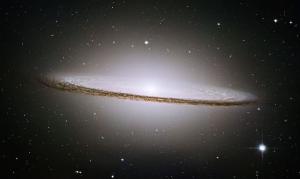Blog
What’s in a Name?
31 March 2018
 NASA/ESA and The Hubble Heritage Team (STScI/AURA)
NASA/ESA and The Hubble Heritage Team (STScI/AURA)Yesterday I wrote about a galaxy containing almost no dark matter. I didn’t mention its name, but it happens to be NGC1052-DF2. Of all the possible names you could give a galaxy, why that one? It all has to do with the history of how the galaxy was discovered.
Some galaxies have wonderful names: Andromeda, Triangulum, and the Milky Way. Others are commonly known by a descriptive name, such as the Sombrero Galaxy with its distinctive rim of dust, or the Tadpole Galaxy with it’s long trail of stars. Others are named after its discover, such as Mayall’s Object, or Hoag’s Object. But there are billions of known galaxies in the heavens, so most, such as NGC1052-DF2, are known by a catalog name.
The history of galaxy catalogs has its origin with Charles Messier. In the 1700s, Messier was looking for comets, which look like faint nebulous blurs before they become brighter and grow long tails. Other objects known as nebulae also look like faint blurs. To keep from confusing the two, Messier created a list of nebulae. That way when he found a faint blur he could compare it with his nebula catalogue to see if it really was a comet. This became known as the Messier Catalog, and contains 110 objects. Each object is denoted by an M for Messier, and then it’s catalog number. So the Andromeda Galaxy is known as M31. Not all of Messier’s objects are galaxies. Telescopes at the time weren’t powerful enough to distinguish between galaxies and other objects such as globular clusters and planetary nebulae. But 40 of the Messier objects are galaxies, making them the first galaxy catalog.
In 1864, John Herschel published the General Catalogue of Nebulae and Clusters of Stars, containing 5,079 objects. It expanded on the earlier work of his father William Herschel. This was expanded to 7,840 objects in 1888 by John Dreyer, and became known as the New General Catalogue, or NGC. The New General Catalogue was revised in 1973 and 1988, and is the most comprehensive list of nearby (in cosmic terms) galaxies. This is why galaxies often have the name NGC followed by a number.
But our particular galaxy has a hypened addition, and that’s because it isn’t in the main catalogue. It is a companion galaxy to NGC1052. Lots of the NGC galaxies have smaller companions, just as the Large and Small Magellanic clouds are companion galaxies to our own Milky Way. Since the galaxy was discovered by a telescope known as the Dragonfly Telephoto Array, and it was the second companion galaxy to be found, our galaxy has the name NGC1052-DF2.
Catalogs are a powerful tool of astronomers. They help us keep track of objects in the sky, and make sure different objects don’t get confused with each other. The only real downside is that they lead to some rather cumbersome names.